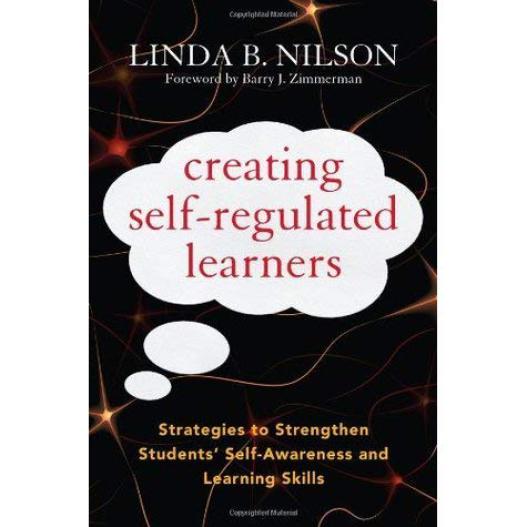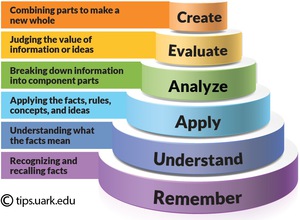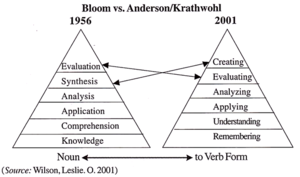
Self-regulation (defined in temporal terms) - processes and beliefs that precede, accompany, and follow efforts to learn, which in turn affect subsequent cycles of learning.
Meta-assignments: involve recording one's thinking and actions and "wrappers" (activities and assignments that direct students' attention to self-regulation before, during, and after learning regular course components).
Deep, lasting learning of any subject matter requires self-regulation.
So does critical thinking, because it entails the reflective, questioning examination of one's beliefs, values, conclusions, and thinking processes.
So does the acquisition of skills, whether mental or physical, because productive practice demands objective self-observation and self-evaluation as well as motivation and perseverance.
Self-discipline - Deferring gratification - Starting tasks early instead of procrastinating -
these behaviors and metacognition are the ultimate study skills for every learner, and the ingredients of life success, and today's students have them in short supply.
Learning is about one's relationship with oneself and one's ability to exert the effort, self-control, and critical self-assessment necessary to achieve the best possible results - and about overcoming risk aversion, failure, distractions, and sheer laziness in pursuit or real achievement - this is self-regulated learning.
Major goal of higher education - to create lifelong learners - intentional - independent - self-directed learners - who can acquire, retain, and retrieve new knowledge on their own.
KNOWLEDGE
1. Strategic Knowledge - heuristic problem-solving method - knowledge of different learning strategies and heuristics for different types of tasks; steps and algorithms for solving problems; need to plan, monitor, and evaluate learning and thinking; and effective strategies for rehearsal (memorizing) like paraphrasing, summarizing; and organization of material (concept-mapping)
2. Knowledge about cognitive tasks - comprehending directions, assessing the task difficulty, deciding wisely which strategies to use
3. Self-knowledge - knowing one's strengths and weaknesses, judging one's command of the material, knowing what strategies work best for you
Deep, lasting, independent learning requires a range of activities - cognitive, affective, and even physical - that go far beyond reading and listening. It entails:
1. setting learning goals for a class period, assignment, or study session
2. Active listening, taking notes, outlining, visually representing the material
3. Occasionally self-quizzing, reviewing, or writing a summary
Character, or at least some aspects of it, plays a major role in defining self-regulated learning.
Self-control, self-discipline, perseverance, and determination in pursuing long-term goals outweigh IQ.
Perceived task value, a "mastery or learning" goal orientation
Help seeking
Use of proven cognitive learning strategies
Control of study-related behavior and environment
Metacognition: one's conscious control over one's cognitive processes - such as focusing on given input, dialoguing with it, observing one's preoccupations and consequent resistance to novel or conflicting inputs, and reviewing and reflecting on an experience.
The awareness and knowledge about one's own thinking
Self-regulation encompasses the monitoring and managing of one's cognitive processes as well as the awareness of and control over one's emotions, motivations, behavior, and environment as related to learning.
BEHAVIOR - self-discipline, effort, time management, help seeking
ENVIRONMENT - use of technology, task management, sensory inputs
Deliberate Practice - experts engage in countless hours of a systematic practice - breaking down elements of a skill or performance - and with each practice carefully monitoring one's performance to identify errors, no matter how minute, in the elements - then isolate the source of each error and strive to correct it with each subsequent practice - it is long, hard, repetititive work - mentally demanding, emotionally straining, life-engrossing - incorporates self-regulated learning!
Theoretical Roots of Self-Regulation
3 practices to foster students' self-efficacy and learning
1. self-observation and self-monitoring of their performance
2. self-evaluation of their performance against their personal standards and values
3. cognitive, affective, and tangible responses to their performance evaluations, including self-correction
6 other prominent psychological theories:
1. behaviorism - human behavior can be explained in terms of conditioning, without appeal to thoughts or feelings - psychological disorders are best treated by altering behavior patterns
2. phenomenology - science of phenomena as distinct from that of the nature of being - study of consciousness and the objects of direct experience
3. information processing
4. volition - power of using one's will
5. Vygotsky - social development theory - social interaction precedes development - consciousness and cognition are the end product of socialization and social behavior
6. constructivism - learning is an active, constructive process - people actively construct or create their own subjective representations of objective reality - new info is linked to prior knowledge
Self-regulated learning takes place over time:
|
Before learning session |
During learning session |
After learning session |
|
Planning Forethought Task analysis (goal setting, strategic planning) Self-motivation beliefs (self-efficacy, expectations, intrinsic interest, goal orientation)
|
Monitoring Performance or volitional control Self-control (use of imagery, self-instruction, attention focusing, application of task strategies) Self-observation (self-recording, self-experimenting) |
Evaluating Self-reflection Self-judgment (comparison between one’s prior performance, another’s performance, or a standard) Self-reaction (self-satisfaction, motivation, adaptive/defensive adjustments)
|
Emotional control – essential part of self-regulated learning
Benefits of self-regulated learning:
- Student performance / achievement
- Amount and depth of student thinking
- Students’ conscious focus on their learning
- Development of reflective and responsible professionalism
Self-efficacy theory: a sense of control, choice, and volition enhances a person’s motivation to perform a task
Self-regulation also contains elements of character and no doubt builds intellectual character. It fosters responsibility, introspective honesty, self-examination, and the pursuit of improvement.
The ability to defer gratification while young, has profound effects on adult behavior and abilities. It fosters goal setting, planning, self-esteem, ego resiliency, stress management, educational attainment, and social and cognitive competency.
Meta-assignments: metacognitive assignments in which students monitor and document their own thinking and actions in completing content-based assignments.
Wrappers: activities and assignments that direct students’ attention to self-regulation before, during, and after regular course components.
Observing a model ‘talking out’ a self-regulatory process may be the first stage of skill acquisition for students, but they must then engage in activities or assignments to develop their nascent skills. To the extent possible, these tasks should be worth something toward the course grade. Giving credit drives home to students the importance we give to learning how to learn, and it need not take more than a few minutes of our time.
Learning how to learn is worthy.
Learning (Your First Job) - Leamnson
Learning to Learn – Wirth and Perkins
Goal setting
Self-assessment of self-regulated learning skills
Self-assessment on course knowledge and skills
- Reflective writing: differs from genre content questions where students analyze and find specific points in the content – pinpoint the most important concepts and principles and identify what you don’t understand clearly. E.g. minute paper, write reading reflections to 3 prompts
- Content-focused writing
- Knowledge surveys
Laying the foundation
Students rarely interact with the text – we need to help our students strengthen their reading comprehension, efficiency, persistence, and retention.
Flip the Classroom: replace as many readings and live lectures as possible with video- and audio-recorded presentations for homework.
Self-testing of recall
SQ3R – survey, question, read, recall, review
PQR3 – preview, question, read, recite, review
Survey/preview: thumb through it first, finding what it is about, looking at headings, subheadings, bolded or italicized words.
Graphics amplify text!
Flowcharts, diagrams, maps, icons, geometric shapes, symbols, outcomes map that takes form of a flowchart.
While highly skilled readers like academics do not notice it, reading text requires recognizing and translating complex patterns of black lines and curves into words, then grouping these words to make meaning. This process takes longer and involves greater effort for students, especially for those with little background in the discipline or who are reading in their nonnative language. Furthermore, many more black lines and curves are needed to communicate something in text than in a visual. Of course, text offers more detail and specificity, but to retain abstract material on a deep level, the mind has to simplify it, strip out unnecessary detail, and organize it into a quasi-visual structure anyway.
Mind mapping: concept maps/mind maps
Lectures: Can hold student attention when delivered dynamically, organized logically, and broken up intermittently by brief activities during which the students apply, analyze, or otherwise work with the new content they just received.
Pre-lecture Activity
- Knowledge survey at beginning of class session
During-the-lecture Activity
- Clicker Questions (ConcepTests)
At the end of a 15-25 min minilecture, display a slide with a multiple-choice item testing students’ conceptual understanding of the content with 4 to 5 options – takes 3 min for 1 or 2 questions.
- Student Questions Identified by Level
- Pair and Small group activities
- Cooperative note-taking pairs – pause lecture, they pair up and share notes
- Scripted cooperation – one student summarizes the other gives feedback
- Periodic free recall with pair and compare version 1 – take notes after lecture
- Periodic free recall with pair and compare version 2 – take notes during lecture
- Pair/group mock testing and grading – give essay and rubric and have them write model answer then share
- Quick thinks – individuals, pairs, or small groups do this quickly – all the activities help students monitor their understanding while still allowing then to ask questions, correct their
thinking, and learn from each other – couple of minutes
- Correct the error – display short statement, argument, prediction, implication etc. with an error
- Complete a sentence starter – display first half, let them finish
- Compare and contrast – similarities and differences
- Reorder the steps
- Reach a conclusion
- Paraphrase the idea
- Support a statement
Closing Activities
- Pair activities
- Closure note-taking pairs – one student summarizes her notes to the other
- Pair review – display a list of topics – students pair off and recall as much as they can
- Multiple-choice test items – pairs make a multiple-choice test question and add it to the bank
- Writing activities
- Minute papers – some prompts
- Most useful or valuable thing(s) I learned…
- Most surprising or unexpected idea(s)…
- Idea(s) stands out in my mind…
- How am I reacting emotionally?
- What helped or hindered my understanding?
- Most confusing points, and why were they confusing?
- Idea that I can put into practice immediately…
- Paraphrase key content for a high school student…
- How does the material connect or conflict with prior knowledge, beliefs, or values?
- How does the material connect with knowledge from other courses?
- Ho w does the material fit into existing framework of knowledge?
- RSQC2 – recall, summarize, question, connect, comment
- Active listening checks – 3 key points, or 4 main ideas, be listening for them in class and hand them in at the end
- Minute papers – some prompts
- Student-created visuals
- Individual/pair/ group graphic
- Memory or knowledge matrix
Meta-assignments
- Heighten students’ awareness of the course content and skills that the regular assignments are helping them learn
- Develop students’ self-regulated learning skills, which enable them to learn the material better and at a deeper level
- Self-regulated learning skills are well worth acquiring – help students learn not only content and other skills but also how to learn, which includes goal setting, strategizing, self-observation, self-testing, reflection, and self-evaluation
- Mathematically based problems
Turning student errors into learning opportunities
Have students write an error analysis of every problem solution they do not complete or get wrong
The students should identify the reasons that they did not obtain the correct answer
The students should then successfully solve it and a similar problem
Also, the students could jot down a few words about their confidence level right after they read a problem and again after they think they have solved it or have given up on solving it
In-class activity: Think Aloud – one student talks out his process of solving a problem while the other records his strategy and guides him as needed. Then the partners switch roles for the next problem
- Authentic “fuzzy” problems
A “fuzzy” problem is embedded in a realistic, troublesome situation and complex enough to defy a clearly correct solution
While multiple solutions exist and some may be better than others, they all exact trade-offs – maximizing some values while undermining others – and present risk and uncertainty
- engaging case studies
- problem-based learning (PBL)
While the regular assignment may be to develop, present, and justify the best solution to the problem, the equally important meta-assignment is for students to describe the steps of the process they followed in arriving at their solution and judging it as the best
While our interest in meta-assignments is to foster self-regulated learning, they can also serve as a classroom assessment technique (CAT) called documented problem solutions
Collections of cost-free cases and PBL websites:
University of Delaware PBL Clearinghouse
National Center for Case Study Teaching in Science
- Experiential learning formats
Offers rich opportunities for self-regulation
- Service-learning
- Fieldwork
- Internships
- Simulations
- Role-play
- Papers and projects
- Student portfolios
Electronic format - ePortfolio
Self-regulated learning from exams and quizzes
Look at them as both summative and formative – occasions for feedback, correction, and improvement as well as grades
Activities and assignments to prepare for exams
- Student-developed test questions
- Student-created review sheet – group activity – 3 out of 4 steps
- Students list the major content areas – brainstorming
- Students designate relative importance of each content area (%) – lively debate
- Within each content area, students list what they think they should be able to do or demonstrate with that content
- Students then prepare to do or demonstrate these learning outcomes
- Pre-exam knowledge surveys
Students rate their confidence level on this scale
|
Very Confident
|
Somewhat Confident |
Not Sure
|
Not at all Confident |
Adobe Acrobat document [253.5 KB]
Adobe Acrobat document [23.2 KB]
Activities during an exam
Rate your cognitive level
|
|
Level 1 Knowledge and comprehension
|
Level 2 Application |
Level 3 Structure of the material, analogy, hierarchy
|
|
BEFORE EXAM |
|
|
|
|
DURING EXAM |
|
|
|
Activities and assignments after exams and quizzes
- Post quiz reflection and self-assessment
- Post quiz or post exam corrections and reflections
- Immediate post exam self-assessment (few minutes after exam)
- What do you think your grade will be on this exam?
- On a scale from 1 to 10, about how much effort did you put into studying for this exam?
- How many hours did you study for this exam?
- How did you study for this exam (what study techniques)?
- Which parts of the exam did you find the most difficult? Why?
- Which parts of the exam did you find the easiest? Why?
- (after grades come out you will have a teachable moment!)
Post graded exam self-assessment
Along with the graded exams, give students a form with open-ended questions:
- How did your actual grade on this exam compare with the grade you expected?
- How do you explain the difference, if any?
- How do you feel about your exam grade?
- Are you surprised, pleased, relieved, disappointed, or what?
- How many hours did you study for the exam?
- Was this enough time to get the grade you wanted, or should you have spent more time preparing?
- How did you spend your time preparing for the exam?
- How effective were these study strategies?
- Examine the items on which you lost points and look for patterns.
- Set a goal to get a certain percentage correct in the next exam.
- What study strategies and schedule will enable you to earn that score?
Posttest analysis – test autopsy – test postmortem
4 common reasons:
- Carelessness – lack of concentration, rushing
- Unfamiliar material – what the student failed to study
- Misinterpreted question – misread or overcomplicated it
- Did not complete – poor reading skills or time management
Post exam activities prompt students to examine more than their grade and to glean diagnostic and learning value from their errors. In particular, post exam activities help students identify and take responsibility for their own strategic mistakes and shortfalls preparing for and taking exams. In turn, students begin to internalize their locus of control. Moreover, these exam wrappers benefit the students who need the most help – the underprepared, lowest-achieving students, who rank lowest in self-regulated learning skills and have the most to gain by acquiring them.
Frequent, regularly scheduled assignments and activities
- Watching you model thinking (Stump the Chump – demonstration in class during which students present you with very difficult problems or questions – requiring expert thinking – and you self-talk aloud as you think your way to an answer and evaluate it
- Knowledge surveys
- Online discussions
- Journaling on learning (consider having your students journal on the following topics):
- Their answers to clicker questions in class, including how discussing them with their peers changed their answer
- Their responses to new experiences, events, knowledge, or information
- Their thoughts, feelings, or opinions on the week’s material and its value
- Their insights into how they learn
- Instances when they achieved clarity or experienced fragments of knowledge falling into place in their learning
- Connections they made among the week’s readings, lectures, class activities, laboratory, field observations, and everyday life
- Improvements they noticed in their writing, public speaking, group interactions, or organizational skills
- Learning strategies they used or tried for the first time, and how effective they were
- Ways they improved their learning strategies
- How they saw the course material reflected in everyday experiences
- What they learned about themselves
- What mistakes they made and successes they enjoyed in their learning, homework, and class activities
Occasional reflective writing
On any schedule
Deferring gratification is a form of self-regulatory behavior, and procrastination is a form of self-regulatory failure.
Learning how to defer gratification is key to life success
Chronic procrastination hinders success
Setting the stage for student success – set the stage for student achievement in your course from the first day of class by creating conditions that lower students’ stress level, foster their motivation, and enhance their self-efficacy. Therefore, consciously establish a positive atmosphere of emotional safety, encouragement, trust, and support. Get to know your students and let them get to know you. Learn and use their names. Convey openness, approachability, and warmth. Be animated and enthusiastic. Smile. Display your sense of humor, your enjoyment of teaching, and your passion for your discipline. Help students get to know one another with icebreakers and in-class group activities and build a sense of community.
Encouraging deferred gratification
Saves them from a lot of irritation and misery as well as enhances their chances for success socially, psychologically, educationally, and eventually, financially.
Implementing instructor strategies
- Have students write down their goals for doing well in your course and for completing substantial assignments, along with a timeline for reaching those goals
- Encourage students, especially freshmen, to schedule their week
- University of Minnesota Assignment Calculator
- University of Wisconsin Time Management Calculator
- Assign students the task of observing themselves while they study and identifying their “positive distractors”
- Provide challenging, long-term assignments that require higher order thinking and break them into steps with deadlines
- Set up a token economy that incentivizes deferring gratification
- Have individual students or groups compete to see who can defer gratification the longest
- Have students write an analysis of the personal benefits they have experienced as a result of deferring their gratification
Helping students overcome procrastination
Heightening students’ self-awareness – procrastination involves self-deception and often deception of others as well
Because of the self-deception, denial, and anxiety underlying procrastination, some students avoid admitting the behavior. Therefore, as you launch your intervention program, you need to raise students’ self-awareness by familiarizing them with the signs of procrastination
- Waiting to do things until the last minute
- Not setting or not honoring personal deadlines
- Not taking action until a crisis develops
- Not setting daily schedules and goals for using one’s time
- Not setting personal priorities for accomplishing tasks
- Spending substantial time unproductively doing trivial or routine tasks, reading nonessential material, and socializing face-to-face, on the phone, or on social media
- Saying yes to every request and invitation
- Overcommitting, overscheduling, and overextending oneself
- Doing a task too quickly and sloppily, which may require redoing it later
- Setting perfection as the standard of a task
- Leaving so little time to do a task that one cannot accommodate unexpected emergencies
- Not reading or listening to instructions on how to do the task
- Pretending to work on the task but never getting around to committing words to paper
- Not asking others to help or to pick up other tasks
Implementing instructor strategies
Five-step plan for die-hard procrastinators by Burns
- It is difficult to combat procrastination. Keep a running list of the unexpected difficulties you encounter.
- Keep a running list of the personal costs and benefits of not procrastinating.
- Break a major assignment that is due around the end of the term into small steps.
- Record any negative thoughts you have about your efforts, along with your strategies for tuning them out.
- Write down how you are rewarding yourself for defeating procrastination.
Beyond time management
Closing the course opening
- Earning an A – or Not
- “how I earned an A in this course” essay
- Self-assessment on metacognitive skills
- 27 item Metacognitive Activities Inventory (MCAI)
- Self-assessment on course knowledge and skills
- Reflective writing
- Content-focused writing
- Knowledge survey
Adobe Acrobat document [312.7 KB]
Stand-alone closing activities and assignments
- “Future uses” paper
- Identify the 3 most important concepts or skills they learned in your course and explain why they consider then so important – in particular, how they expect to use these concepts and skills in the future
- Skills grid
- Letters to the next cohort
- Letters peak from experience in advising later students on how to succeed in a course and why they should bother – summarize what, according to outgoing students, are the most valuable study and assignment strategies and most interesting and important content and skills in a course
- Solicit letters only from A-students
Bringing course to a close
Not for grading
- Class discussion on learning/thinking readings
- Class brainstorming on ways to earn an A in the course
- Self-testing in recall-and-review reading procedures (RSQ3R, PQR3)
- Pre-lecture active knowledge sharing
- Clicker questions
- Student questions identified by level
- Pair and group activities during lecture
- Quick-thinks lecture-break activities
- Post-quiz reflection and self-assessment in pairs or groups
- Pair activities to close lecture
- Think Aloud on homework problems in pairs
- Reasoning practice (after instructor models) in pairs or groups
(Hold students accountable by cold calling on individuals, pairs, or groups to report out)
For grading with a rubric
- Meta-assignments on authentic fuzzy problems (describe thinking process) – may also be suitable for specs grading
- Reflective meta-assignments on experiential learning: service-learning, fieldwork, internships, simulations, and role-plays – may also be suitable for specs grading
- Meta-assignments on portfolios (any kind) – may also be suitable for specs grading
- Self-assessment on course knowledge and skills (reflective writing on subject matter or content-focused writing, such as letter to pre-class self or value- added essay final) – end of course
- “Future Uses” paper
For Specifications Grading
- Aka specs grading
- You lay out one or more requirements for an assignment and grade a student’s work “pass”/full credit if it meets all the specs or “fail”/no credit if it does not
Past examples of Specs Grading
Specs grading of self-regulated learning assignments
- Writing answers to questions on learning/thinking readings
- Writing course goals
- “How I earned an A in this course” essay - beginning of course
- Self-assessment of self-regulated learning skills (metacognitive activities awareness inventory, questions about how one learns) – beginning and end of course
- Self-assessment on course knowledge and skills (reflective writing, content-focused writing) – beginning of course
- Knowledge surveys – beginning and end of course
- Reflective writing on readings, videos, or podcasts (questions about how one learns, study cycle questions, free written summaries, personal reactions, minute papers)
- Answers to genre content and study questions on readings, videos, or podcasts (including student-developed test questions)
- Retrieval-practice quizzes and mind dumps
- Visual representations of readings, videos, or podcasts (maps, diagrams, flowcharts, matrices)
- Student-developed test questions on lectures
- Minute paper to close lecture
- RSQC2 to close lecture
- Active listening checks to close lecture
- Visual representation of lecture (maps, diagrams, flowcharts, matrices)
- Meta-assignments on mathematically based problems (confidence assessment, error analysis)
- Meta-assignments on authentic fuzzy problems (describe thinking process) – also suitable for grading with a rubric
- Reflective meta-assignments on experiential learning: service-learning, fieldwork, simulations, and role-plays – also suitable for grading with a rubric
- Meta-assignments on papers and projects (description of research process, problems overcome, skills acquired, self-assessment of work, development of self, revision plans, paraphrase of instructor feedback, letter to next class about assignment
- Meta-assignments on portfolios (any kind) – also suitable for grading with a rubric
- Activities and assignments to prepare for exams (student-developed test questions, student-centered review sheets/test blueprints, knowledge surveys on test material)
- Self-confidence ratings during exams
- Post quiz or post exam written corrections and reflections
- Immediate post exam written self-assessment
- Study game plan for the next exam
- Test autopsy
- Frequent knowledge surveys
- Frequent online metacognition discussions
- Weekly journaling on learning
- Occasional reflective writing assignments
- Writing assignments to encourage deferring gratification
- Writing assignments to overcome procrastination
- “How I earned an A in this course or NOT” essay – end of course
- Skills grid
- Letter to the next cohort
Broader uses of specs grading
How much to count self-regulated learning assignments
Minimalist grading
Beginning of the course
- Discussing or writing answers to questions on learning/thinking readings
- Writing course goals
- “How I earned an A in this course” essay
- Self-assessment of self-regulated learning skills
During the course
- Study game plan for the next exam
- Frequent online metacognition discussions
- Weekly journaling on learning
- Occasional reflective writing assignments
- Writing assignments to encourage deferring gratification
- Writing assignments to overcome procrastination
End of course
- “How I earned an A in this course – or not” essay
- Letter to the next cohort
Your outcomes and your syllabus
- Explain what learning involves and how this is different from what they thought previously
- Identify and plan the behaviors that are necessary to do well in the course
- Set goals for their learning in the course
- Assess their progress toward these goals on a regular basis
- Accurately summarize and retain the main points from readings, videos, podcasts, and live lectures
- Consciously observe and evaluate their own thinking, affective responses, and actions in solving problems, conducting research, writing papers, working on projects, performing service, negotiating a simulation, role-playing, conducting fieldwork, working in an actual job, or evaluating their own products
- Practice self-discipline and defer gratification in scheduling their time wisely and honoring that schedule
- Set performance goals for their exams and major assignments
- Study more effectively for exams
- Abandon learning strategies that are not working well and try others that are likely to work better
- Solve problems and perform tasks that they couldn’t in their first assessment
- Predict their performance on an upcoming quiz, exam, or homework problem with high accuracy, avoiding overconfidence
- Accurately interpret instructor and peer feedback
- Revise their work according to a plan that addresses the concerns raised by the instructor and peer reviewers
- Explain how they received the grade that they did
- Explain the connection between their learning strategies and effort and their performance on homework, quizzes and exams
- Explain the skills they have acquired or refined during the course and the contexts in which those skills will be useful
- Describe how they have changed their values, beliefs, attitudes, behaviors, ways of thinking, standards of evidence, or understanding of phenomena as a result of taking the course
Contact Me
Sarah Nilsson, J.D., Ph.D., MAS
602 561 8665
You can also fill out my
Get Social with Me
Legal Disclaimer
The information on this website is for EDUCATIONAL purposes only and DOES NOT constitute legal advice.
While the author of this website is an attorney, she is not YOUR attorney, nor are you her client, until you enter into a written agreement with Nilsson Law, PLLC to provide legal services.
In no event shall Sarah Nilsson be liable for any special, indirect, or consequential damages relating to this material, for any use of this website, or for any other hyperlinked website.
Steward of
I endorse the following products
KENNON (sun shields)











